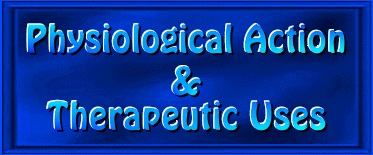


The following is excerpted from The Professional's Herbal Formula Handbook No. 17, comprising 100 pages of traditional information and recent scientific data that describes the medical properties, physiological action and therapeutic uses for each of the 24 ingredients outlined in this formula.




Adaptogenic, alterative, anabolic, anti-aggregant, antibiotic, anti-cachexic, anti-dyscratic, anti-fatigue, anti-infective, anti-lithic, antioxidant, antiphlogistic (anti-inflammatory, anti-sclerotic, antiseptic, anti-thrombotic, astringent, bacteriostatic (anti-bacterial), cardiotonic, cytophylactic, cytotoxic, decongestant, deobstruent, depurative, detoxicant, disinfectant, diuretic, hemostatic, hypocholesterolemic, hypotensive, lithotryptic, microbicidal (anti-microbial), nutritive, prophylactic, rejuvenative, relaxant, stimulant (circulatory and secretolytic), tonic, constitutional tropho-restorative, vasodilator and vasotonic.


Alleviates any general fluids dyscrasia (abnormal or pathological condition) within the blood vessels (arteries, veins and capillaries) throughout the entire circulatory system (as well as the mucous membranes or tissue-systems throughout the entire organism) that leads to the onset of various degenerative or debilitative conditions associated with various circulatory system imbalances (including anemia, arrhythmia, arteriopathy, capillary engorgement, capillary fragility, capillary permeability, cardiac hypoxemia, cardiovascular erethism, coronary sclerosis or thrombosis, fatigue, global parasympathetic inhibition, hypercholesterolemia, hyperlipidemia, hypoxia, peripheral circulatory insufficiency, sepsis (blood poisoning), blood or capillary stasis, venous insufficiency, and general weakness), and eliminates any cachexia (state of malnourishment and general debility) throughout the entire organism in order to provide increased protection against any systemic or localized nutritional deficiencies or insufficiency that leads to various circulatory system disorders; acts as a secretolytic stimulant in order to promote increased gastric, pancreatic or intestinal secretory and motor activity, and enhances greater peripheral circulation (due to its antioxidant activity); exhibits significant antioxidant effects in order to provide greater oxygen-transport capabilities throughout the entire circulatory and cardiovascular systems, as well as enhance the transport of additional oxygen directly into the cells and tissue-systems throughout the blood vessels (arteries, veins and capillaries); acts as a circulatory stimulant by increasing the blood flows throughout the circulatory system in order to enhance greater nutrient transport, absorption and utilization, thereby accelerating the healing processes associated with the repair of any nutritional deficiencies or insufficiency throughout the entire organism; displays anti-sclerotic and hypocholesterolemic properties in order to eliminate any hypertension or congestion associated with hypercholesterolemia (excessive cholesterol levels in the bloodstream) by reducing the total serum cholesterol, triglyceride, fatty acid and low density lipoprotein (LDL) levels while increasing serum high density lipoprotein (HDL) cholesterol levels (which inhibits the formation of atherosclerosis) during those conditions involving hyperlipidemia (elevated lipids or fats in the blood), which is accomplished through the mechanism of accelerated degradation, conversion and excretion of cholesterol and triglycerides; eliminates any general debility or weakness caused by impaired circulation, and acts as a circulatory decongestant (especially throughout the veins and capillaries); exhibits hemostatic activity in order to more rapidly reduce the blood-clotting time, and acts as an anti-coagulant and hemostatic in order to remove any venous blood stasis (stagnation); displays significant anti-aggregant, anti-coagulant and anti-thrombotic activity (due to the presence of the coumarin aesculin) in order to prevent blood platelet aggregation or blood clotting by inhibiting any further exposure of the fibrinogen receptors located on platelet membranes, thereby enhancing greater overall effectiveness against the onset of atheriosclerosis; reduces any peripheral resistance, thereby lowering the blood pressure; acts as a prophylactic against the onset of atherosclerosis, and removes any coronary sclerosis or thrombosis, tachycardia or fluid congestion in the heart (accompanied by fatigue, nausea or vomiting, general muscular weakness and peripheral or central edema); displays anti-lithic and lithotriptic activity in order to remove any crustaceous and calcareous deposits in the lumen of the arteries, and reduces the size of any existing atherosclerotic plaques (due to the presence of flavonoid compounds); possesses certain flavonoid components (in the form of anthocyanidins and proanthocyanidins) in order to increase intracellular vitamin C levels, stabilize vitamin C (by protecting it from destruction or oxidation) and reduce capillary permeability or fragility, and removes any cardiovascular degenerative disorders or coronary artery disease (due to the presence of these flavonoid compounds); relieves any significant loss of cardiac function, and relaxes the heart and the entire circulatory system; inhibits the contriction of blood vessels by preventing the deposition of cholesterol in arterial walls, and displays hypotensive and cardiotonic activity in order to (1) improve the blood supply to the heart by dilating the coronary blood vessels, (2) enhance the metabolic processes in the heart (which increases the force of contraction of the heart muscle), and (3) inhibit the angiotensin converting enzyme (ACE) that is responsible for converting angiotensin I to angiotensin II (which is a potent constrictor of blood vessels); displays vasodilator effects, due to the presence of flavonoids (hyperoside, procyanidin, quercetin, rutin and vitexin); exhibits vasodilator activity in order to dilate the coronary blood vessels (which supply vital oxygen and essential nutrients to the heart) by promoting increased relaxation of the smooth muscle components of the blood vessels, and relieves any global parasympathetic inhibition accompanied by passive vasodilation; demonstrates significant vasodilator effects in order to remove any cardiac hypoxemia, and relieves any dyspnea (difficult breathing conditions) associated with heart action disturbances or a lack of sufficient oxygen supply in the blood (hypoxia); reduces any heart blood congestion accompanied by shortness of breath, cyanosed lips or nails, and stabbing cardiac pain that radiates down the left inner arm, and removes any rapid or feeble heart action associated with atherosclerosis by increasing the strength of heart muscle contractions in order to reduce the heart rate; regulates any disturbances in heart rhythym or arrhythmia (such as tachycardia or extracystoles), and inhibits any enzymatic cleavage (due to the presence of anthocyanidins, proanthocyanidins and other flavonoids) by certain enzymes that are secreted by white blood cells during various inflammatory conditions; relieves any myocardial weakness, myocarditis, endocarditis, pericarditis, and cardiac weakness or failure, and removes any mitral valvular deficiencies or insufficiency, cardiac edema, palpitations, functional derangements of the heart or fibrillation in the heart muscle; displays astringent properties in order to strengthen the functional capabilities of the spleen (which is responsible for filtering the blood and releasing compounds that potentiate immune function), thereby maintaining proper blood supplies within the arteries, blood vessels and capillaries throughout the entire circulatory system; exhibits cytophylactic and cytotoxic activity in order to provide stronger cellular defense mechanisms against many physical or chemical agents, and displays anti-infective and disinfectant properties in order to promote increased resistance by destroying any invasive or harmful pathogenic bacteria, microbes or viruses that are often responsible for various infectious states or inflammatory conditions; exhibits bacteriostatic and microbicidal activity in order to strengthen and increase the resistance of the circulatory system against any invasive or harmful bacteria or microbes, as well as to inhibit the further development of any infectious or inflammatory conditions associated with the onset of various circulatory system disorders; demonstrates significant antiphlogistic effects in order to inhibit the formation of certain inflammatory compounds (such as histamine, leukotrienes, prostaglandin, serine proteases and thromboxanes), as well as to reduce any severe inflammatory swelling associated with any degenerative conditions by exerting an extremely positive influence towards correcting any internal inflammatory conditions throughout the entire circulatory system (including the arteries, veins and capillaries); exhibits significant antiseptic activity by destroying the vitality of any organized living ferments in order to prevent the onset of putrefaction or septicemia, and precipitates the proteins in any inflamed tissues in order to provide a mildly antiseptic and protective coating (under which the regeneration of new tissue occurs) for the mucous membranes and tissue-systems throughout the entire circulatory system; acts as an effective antiseptic in order to remove any septic conditions associated with tissue degeneration or ulceration, and promotes increased suppuration and a steady toning or restorative impression to the entire glandular system (especially the liver, spleen and lymph glands); exhibits anabolic activity in order to accelerate the production of DNA and RNA (which enhances the production of proteins in the form of antibodies), while increasing protein and lipid synthesis in the bone marrow and DNA/RNA content in the adrenals and lymph nodes (along with increased body weight and enhanced re-synthesis of glycogen and high-energy phosphate compounds); demonstrates powerful adaptogenic (balancing and strengthening) activity in order to increase the overall resistance of an organism towards any adverse influences or stressful conditions (whether they be physical, chemical or biological), especially throughout the immune system, blood vessels, musculature, skeletal structure, and both the central (cerebro-spinal centers) and peripheral nervous systems; acts as an effective nutritive and rejuvenative tonic to the arteries, veins or capillaries during convalescence (due to the presence of rich sources of calcium, carbohydrates, chromium, cobalt, fats, iron, magnesium, manganese, niacin, phosphorus, protein, selenium, silicon, sodium, zinc and vitamins A, B1, B2 and C) in order to enrich, nourish and replenish any nutritional deficiencies or insufficiency throughout the circulatory system, which leads to the development of various degenerative or debilitative conditions (such as nutritional anemia, fatigue, sepsis (blood poisoning), venous or capillary stasis (stagnation), general weakness, and impaired circulatory flows); demonstrates significant rejuvenative and restorative properties upon the basic plasma tissue-systems throughout the entire organism, thereby enhancing the production of vital bodily fluids while providing greater enrichment through increased assimilation of the various organic mineral salts; accelerates the recuperative processes that are essential in order to overcome any chronic degenerative or debilitative diseases or illnesses, while facilitating greater recovery response during convalescence in order to fully regain optimal health and well-being; demonstrates cardiac tropho-restorative effects in order to enhance greater functional capabilities in the heart tissue, and acts directly upon the damaged heart muscle in order to improve its functional efficiency without placing any undue strain upon the vascular system; improves the efficiency of the heart muscle without increasing the need for additional oxygen, thereby enabling the heart to pump sufficient blood throughout the system without producing any excessive accumulations of fluid in the lungs or bodily extremities; promotes greater availability and utilization of energy-reserves within the heart, thereby facilitating enhanced flavonoid-enzyme interactions and long-term or sustained effects (increased blood and oxygen supply) upon any degenerative conditions in the myocardium (middle cardiac muscle layer of the heart wall); inhibits several key enzymes within the myocardium (e.g., cyclic adenosine monophosphate phosphodiesterase) that results in an increase in the force of contraction, and restores myocardial reserve while enhancing the healing processes during convalescence from any myocardial infarction; activates the bodily processes of detoxification and elimination in order to cleanse and purify the bloodstream and tissue-systems, and acts as an eliminative vasotonic to the blood, liver and splenic functions (as well as upon the eliminative functions of the lymphatic system); enhances the overall cleansing process by dilating the surface capillaries in order to more effectively remove any toxic debris or metabolic waste materials through the pores of the skin, and increases the secretion and elimination of urine in order to provide further support to the inner cleansing process; displays alterative activity in order to correct any disordered bodily function, thereby activating increased alterations in both metabolic and tissue functions as a defensive measure against the onset of acute or chronic disease; exhibits restorative effects in order to regain increased vigor or vitality and greater strength, while enhancing normal tissue and metabolic functional capabilities; demonstrates alterative and restorative properties in order to re-establish healthy systemic functional capabilities, as well as to establish greater vascular tone throughout the entire organism (due to its ability to stimulate increased secretory flows); exhibits alterative effects in order to stimulate the anabolic growth processes, thereby enhancing the repair of any degenerated, deteriorated and debilitated cells or tissues (while promoting the elimination of any catabolic waste materials); displays tonifying effects in order to permanently enhance the overall energy-levels throughout the entire organism, without adversely affecting the functional capabilities of any particular organ or system.
![]()
None.
![]()